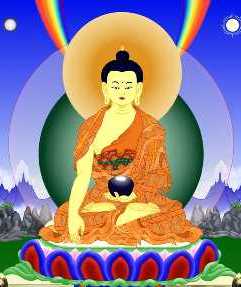Firstly, we must convincingly demonstrate that only the Buddhist diagnosis of the human condition can give a sufficiently profound explanation of our ecological and social ills: Why, for example, is human kind turning out to be so suicidally destructive? This means that we must expose the inadequacy of the prevailing Social fallacy. This assumes that global problems are exclusively economic and political in origin and likewise that their remedy lies in the adoption and improvement of specific social systems. So-called underdeveloped countries, for example, can eventually overcome their problems by industrialising themselves into free market consumer societies.
Buddhism, however, maintains that although there are positive and radical social developments which 'can relieve much suffering, by themselves these will always ultimately disappoint us. This is because they will be distorted and shaped by the aggressive and acquisitive character of our deluded root human condition - Buddha's `Three Fires'. (This is the most striking lesson of the failure of the Communist dream of human liberation). Consequently, our analysis (or rather, our understanding) must begin with the nature of human beings themselves. Social structures and processes are indeed hugely important, but still nevertheless only secondary
Buddhism thus returns social science to its existential roots. For example, it invites economists to consider its claim that acquisitiveness originates as much in the root insecurity and angst of the human animal as in its physical needs. This is illustrated alike by the flaunting conspicuous consumption of the wealthy ruling minority throughout history and by characteristic behaviour in the affluent societies of the world.
Secondly, we do nevertheless need to develop a Buddhist social theory which will both be taken seriously by educated non-Buddhists and which can explain the complexity of modem social life without secularising or diminishing Dhamma. Parading yet again all the social passages from the suttas is just not good enough! Buddhism offers a diagnosis of the human condition almost wholly in terms of the person. Only comparatively recently has social evolution become sufficiently dynamic and complex as to stimulate the development of explicatory social theories. In my book The Social Face of Buddhism (Wisdom 1989) I argued that phenomenological social theory provides a highly appropriate amplification of basic Dhamma. From the time of our birth, we each not only respond to the precariousness of our human condition in a personal sense, but as inheritors of delusive meanings about the world. these latter become objectified and solidified `out there'. Authority, for example, is seen as `belonging' to someone, instead of an attribute we have given to some one who has power. Similarly, the ideolagies of `us' and `them', good and evil, which bestride our world are mistaken as reality itself, rather than the alienating projections of the insecure and fearful beings that we are. In short, our `personal' kamma is supercharged by, and at one with, a social kamma.
Similarly, the great institutions which embody the aggressiveness, acquisitiveness and divisiveness of Buddha's `Three Fires' appear to take on a life of their own, trapping in `the system' even those who may be reluctant to meet their demands and expectations. In the Over-Developed countries millions of kindly people happily accept `ordinary' lifestyles which are in fact needless yet hugely destructive ecologically and in relation to Third World peoples. A few of the more thoughtful may change to a more frugal, `Green' lifestyle, but unless they are also committed changing the social values and structures ultimately responsible their personal example can have little effect. We are entrained in a headlong global ecosocial kamma which is overwhelming good intentions like the Rio de Janeiro o Earth Summit. These are examples of a socially informed Dhammic perspective which I have developed more fully in my Social Face of Buddhism and in essays like Getting out of our own light* which presents ideology as a key category in Buddhist social analysis of another.
Thirdly, our Buddhist social analysis must be extended so as to be practical and helpful to all who are socially oppressed and exploited, if we are truly brothers and sisters of another Our analysis must make it clear that the inner work of spiritual liberation must go hand in hand with the outer work of eco-social liberation, and that they are ultimately about one and the same Wisdom/Compassion. Meditative insight into our self-created `reality' can free-off energy and courage, as well as bringing clarity. We will' only overcome our eco-social afflictions when enough of us are enough at peace with ourselves, with one another, and with the planet, as t make fruitful our efforts to create, as from now, a society which is ultimately held together by loving kindness (metta), instead of by the power of the State or the greed of the Market. And those efforts, and the non-violent, mutualistic grassroots organisations and structures which we are now creating, must in turn support personal growth just as the old institutions distort and stunt it.
There is no lack of blueprints for ecologically harmonious, democratic, decentralised, self-reliant societies of the future. Whilst these can offer inspirational guidelines they are also commonly flourished as consoling ideological utopias. Our Buddhist social analysis must assist us in helping to create an alternative future in modest and practical ways, well rooted in existing realities. There are now a growing number of such projects in the Third World, some of which are spiritually informed (The Buddhist inspired Sarvodaya movement in Sri Lanka is one instructive example}. In the Bodhisattva tradition, we must be able to share our social understanding with people of other faiths and no faith, without necessarily preaching Buddhism to them.
* In Dharma Gaia: a harvest of essays in Buddhism and ecology. Ed Allan Hunt Badiner. Berkeley, Parallax Press, 1990.


















